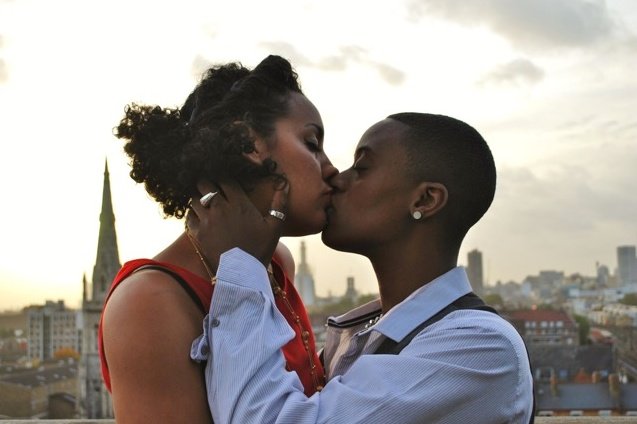Guest post written by Becky Kukla.
Opening Sheffield Doc Fest this year was an unexpected gem in the form of Queerama. Produced entirely out of the British Film Institute (BFI) archives, the documentary outlines the milestones, setbacks, stigma, and celebrations of the LGBTQ movement in the UK from 1919 to the present. It incorporates electro beats, limited dialogue, and some steamy scenes, cut with cards detailing important milestones for the LGBTQ community.
The unusual result comes from the mind of Daisy Asquith, a documentary director probably best known for her funny, yet poignant TV documentary Crazy About One Direction which delved into the lives of One Direction fans. Asquith, who received nothing short of vitriol from the young fans for her film, calmly succeeded in creating a film that was both critical and understanding of young teen culture. She showed us that “Directioners” were every bit as obsessed and in love with One Direction as the media portrayed them to be but also, that we as humans, all have obsessions.
Asquith’s keenness to dissect social ideologies is realized fully in her latest feature film. From the the beginnings of gay relationships on-screen, as early as 1919, right up to the publicly fought battles for adoption rights and marriage equality, Queerama details queer British history in a way it has never been seen before. There are frank interviews with politicians, scientists, and all manner of “experts” where the discussion ranges from homosexuality being sinful, to being reversible with the right therapy, to those who practice it being labelled as mentally ill. There is a strong exploration of the idea of lesbianism as invisible — Queerama points out that there have never been any laws against women having sexual relations with one another.
Weaving previously unseen news footage, with steamy subtextual scenes from the early days of cinema — Queerama is rich in both content and emotion. Certain archival footage brings up feelings of anger, but these are almost always followed with footage of the queer community and of positive representations of LGBTQ culture. The crossing over from fiction to news archive and back again brings up the cyclical nature of art and life. Which imitates which? As we see queer couples becoming publicly intimate on UK television shows of the 1980s, we also watch in horror as the AIDs crisis unfolds.
The soundtrack is glorious (I’ve already made my own playlist on Spotify) and it soars flawlessly from racy, upbeat electro tracks to slower, more melancholic moments. Asquith overlays footage from the 1950s and 60s with contemporary pop music, bringing the visuals into the 21st century. At times, it feels like an educational music video — the songs blurring into one another, barely stopping for the fairly limited moments of dialogue. Songs like John Grant’s “Jesus Hates F*****s,” set against scenes of a very sexual nature, provides more insight into the conflicted identities of LGBTQ folk than a fictional film ever could.
Humor, in the soundtrack and visually, plays a huge part in the documentary. It isn’t a comedy, there is too much tragedy and discrimination for it to be comical, but it’s reflective of the queer British movement. Color, laughter, and celebrations exist amongst the tears. Juxtaposing certain songs and archives against one another — particularly stern experts mixed with the beautifully queer lyrics of Herucles & Love Affair — gives their words less meaning, and it is easier to laugh at the backwards mentalities that certain people hold (and still do).
As a part of the LGBTQ community, I found myself staring at a history that I only partially recognized. A documented, filmed history, real history — most of which I had never looked at. The selection and use of archival footage is truly astounding, and Asquith repeatedly cuts sequences together to create the idea of an expansive queer narrative; a living history, a narrative which spans beyond its reach. Queerama feels like a tapestry. Growing up in the 1990s and 2000s, homosexuality and bisexuality was becoming accepted. There was (and is) still a lot of stigma, bullying, and discrimination but watching Queerama made me realize exactly how far we have come. It’s this progress we need to celebrate, yet simultaneously keep an eye on the past to make sure it doesn’t come back around.
I think everyone, whether you identify as LGBTQ, are an ally, or none of the above, should watch Queerama. Though much as the majority of queer history is persecution, oppression, and erasure, Queerama is a strangely joyful monument to it all. It will make you laugh, cry, dance, and think — quite possibly all at the same time. It says, “Despite it all, we are still here.” It’s a testament to perseverance and to queer visibility.
It is, quite simply, a breathtaking experience.
Becky Kukla works in factual TV by day, and by night she writes about representation in film and television, and rants about politics on twitter. You can find her at Femphile or at Film Inquiry.



